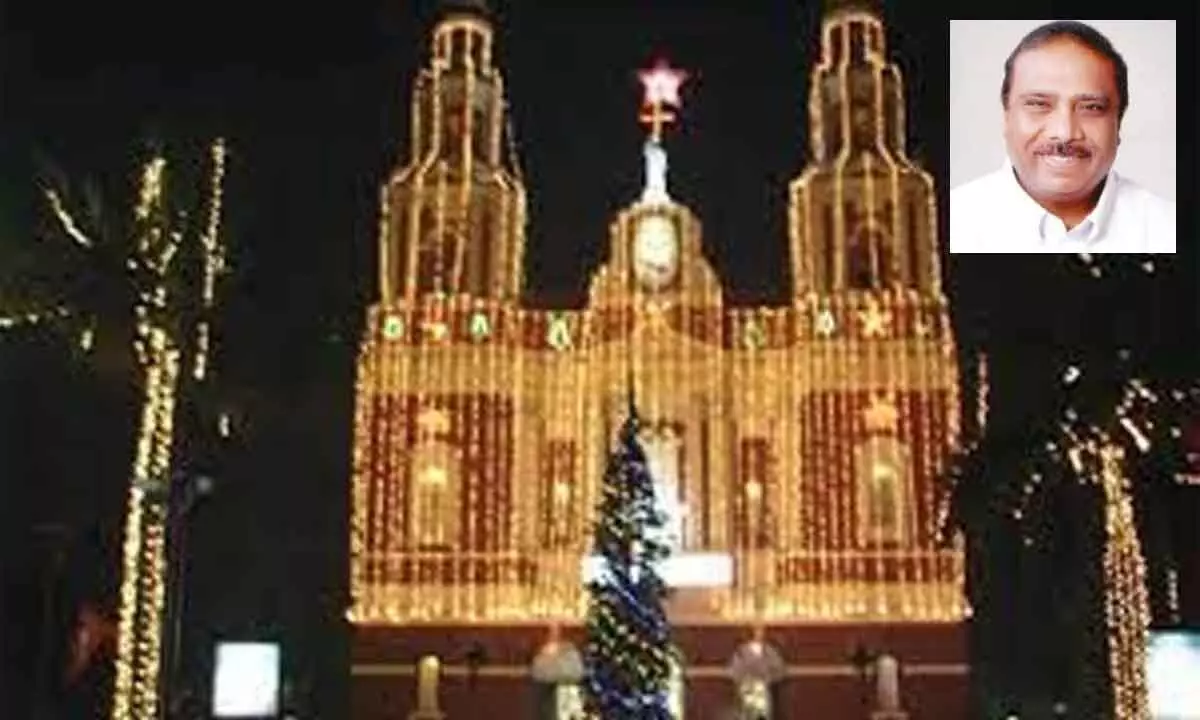Christmas salutation to Henry Medd, the architect extraordinaire
The church specialist served as the Chief Architect to the Government of India from 1939 to 1947
image for illustrative purpose

The then chaplain of the nascent city envisaged a massive Gothic church on the lines of Westminster Abbey. Sir Edwin Lutyens, the architect of Rashtrapati Bhavan, rejected the concept. He felt that Westminster Abbey, with all its glass windows would only be fit for 'frying bacon' in the heat of the Delhi summer. Henry Medd, who eventually designed the Cathedral, heeded Lutyens warning and that is why the Cathedral does not have many windows
Even as Christmas is round the corner and churches across India are bedecked for the grand celebration, it is time to reflect on some iconic churches, especially their architects.
Henry Alexander Nesbitt Medd, more popularly known as Henry Medd, was a young architect, when he came to New Delhi to assist masters like Sir Edwin Lutyens and Herbert Bakar when they were working on a series of new buildings.
While assisting his seniors, Medd made a name for himself while designing two churches that have become the national capital’s landmark structures. One will be spellbound seeing his master class, the Cathedral Church of the Redemption and the Sacred Heart Cathedral.
Incidentally these were that two churches that the then Viceroy used to visit for prayers before India achieved independence. Both were built in the mid-1930s. Before they were built, the Viceroy used to visit St. James Church at Kashmiri Gate.
Medd also designed the High Court building at Nagpur and served as the Chief Architect to the Government of India from 1939 to 1947. When he was barely 23, he joined the office of Lutyens here. And later he worked under the watchful eyes of Sir Herbert Baker for an extended period from 1919-31.Thus, he had the good-fortune of working under two of the greatest architects of their time.
“Generations of people have grown up in these banal buildings of New Delhi. Of course, that’s why architecture is so important. Medd was a master without any debate,” says Father George Solomon, a priest at Holy Trinity church of Delhi,
“Medd was in full flow when he was designing these two churches. He was given complete freedom to practice his philosophy of integrating built-form with landscape as a total environmental concept. Every part of these churches speaks a different language.”
If we talk about the Cathedral Church of the Redemption, it stands tall on a broad base and rises in massive blocks to the tower, topped by a dome. Atop the dome stands a cupola on narrow pillars, carrying a cross, soaring high above the body of the church. The buff sandstone walls contrast with the bright red tiles of the sloping roofs. The absence of windows adds to the giganticness of the architectural marvel.
The Roman Catholic Church of the Sacred Heart is located at Gol Dak Khana Roundabout, and stands out for its exquisitely aristocratic appearance.
“It is a bold and elegant design cast in the Lutyens tradition with an Italianate south front enriched by an oval mosaic. Although, in the same colour scheme as the Cathedral Church of the Redemption, this one is a definite improvement,” informs Father George Solomon.
In the initial days after the capital of India was moved from Calcutta to Delhi, the chaplain of the nascent city envisaged a massive Gothic church on the lines of Westminster Abbey.
Sir Edwin Lutyens, the architect of Rashtrapati Bhavan, rejected the concept. He felt that Westminster Abbey, with all its glass windows would only be fit for 'frying bacon' in the heat of the Delhi summer.
Henry Medd, who eventually designed the Cathedral, heeded Lutyens warning and that is why the Cathedral does not have many windows. The Cathedral Church of the Redemption is located on the north of Jaipur Column at a shouting distance from Parliament House. Though the exterior of the church is ordinary, with red sandstone roofing, the interior is striking.
“The interior of this Anglican Church has small recessed openings that filter the sunlight. It also has a fine organ as well as a striking stained glass window. The best part of Medd’s work was that he used to give lot of space for gardens, which one can find in both churches. It is said that he did extensive research before recommending plantation of neem, jamun and amaltas trees in New Delhi,” says Monodeep Daniyal of Delhi Brotherhood Society that established St Stephen's College and the St. Stephan’s hospital in Delhi.
Noted author R.V. Smith, an authority on Delhi, says, “Even though Medd designed these churches so many decades ago, they still look contemporary and good. I feel that well designed church buildings should convey a clear message and enhance the worship experience. It is my belief that people will continue to be attracted to church architecture that is honest and intentional in its message, meaningful in its experience and which glorifies God.”
Medd had helped Baker a great deal in finalizing the finer details of the Council House (now Parliament) and Secretariat buildings (North and South blocks).
He was a master of building materials and went into the minutest details. He never imposed his ideas on his juniors and other colleagues. He believed in using building materials in their original form.
A contemporary architect, Medd was interested in local culture, conditions and climate. Even after New Delhi took a final shape, Medd decided to stay back and left India only after it got independence. His career bloomed in India and helped him earn eternal fame.
Henry Medd passed away in 1977 leaving behind a timeless legacy.
(The author is Delhi-based senior journalist and writer. He is author of Gandhi's Delhi which has brought to the forth many hidden facts about Mahatma Gandhi)

